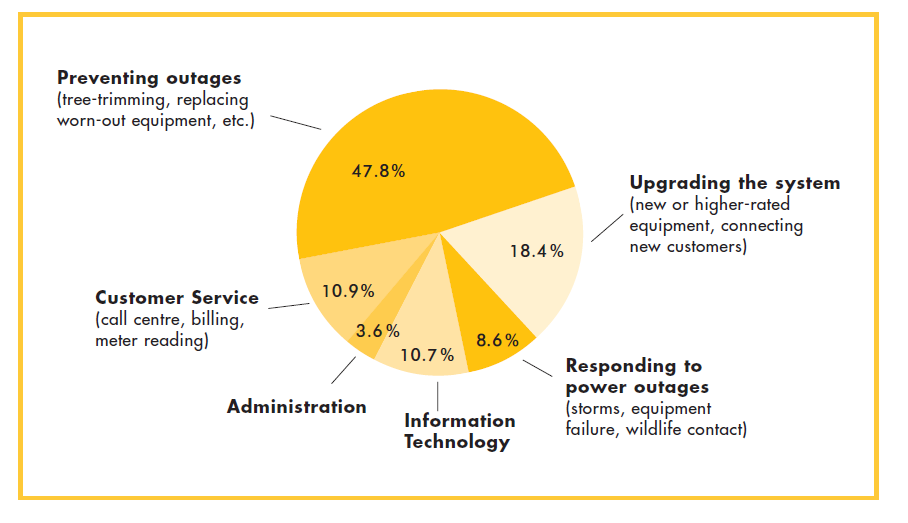Understanding Your Bill
Understanding Your Bill
Electricity bills can be complicated.
We’ve put together a handy guide to help you understand exactly what you’re paying for.
Breaking down your bill
Your electricity bills consist of three main categories; your Electricity charges, Delivery charges, and Regulatory charges.
Electricity
Electricity charges reflect the cost of electricity purchased by North Bay Hydro Distribution Limited on your behalf for usage at your service address and no markup is charged on this cost; it is paid directly to our suppliers.
The pricing rates for electricity typically change once a year in November.
Residential Customers have a choice between: Time-Of-Use (TOU), Ultra-Low Overnight (ULO), and Tiered.
Delivery
Delivery charges cover the cost of transporting electricity from the place of generation, to North Bay’s grid, and finally to your service address. This includes the cost to build, improve, and maintain the transmission and distribution lines, towers, and poles needed to operate provincial and local power grids.
Regulatory
Regulatory charges reflect the cost of administering the wholesale electricity system and maintaining the reliability of Ontario’s grid. North Bay Hydro does not charge a markup on this cost and it is paid directly to the Independent Electricity System Operator.
Customer Choice
As an North Bay Hydro customer, you have the ability to choose between Ontario’s TOU and Tiered pricing plans dependent upon your lifestyle. Tiered pricing allows you to use electricity how you want, when you want but increases in price after reaching a monthly threshold. TOU pricing charges you a different price depending on the time of day, allowing you to find savings by shifting your usage to periods of lower demand.
For more information on Choosing your electricity price plan, visit the OEB website:
Electricity Charges
| Time-of-Use (TOU) | Rates vary depending on the time of day you use electricity. There are three periods: on-peak, mid-peak, and off-peak |
| Tiered Pricing | You pay a set rate for electricity up to a certain threshold. Once you exceed that threshold, the rate increases. |
| Ultra-Low Overnight (ULO) | A new plan offering lower rates during overnight hours. |
With TOU and ULO, the price depends on when you use electricity. This means you can help manage your electricity costs by shifting your usage to lower price periods when possible.
With Tiered, the price depends on how much electricity you use overall in a month.
For more information about your electricity price plan, visit the OEB website.
Delivery Charges
Delivery charges covers our costs to deliver electricity to your home safely and reliably. These costs include keeping the system safe and reliable, restoring power, transmitting and distributing electricity and providing fast and flexible customer service. The OEB sets our delivery rates.
North Bay Hydro includes the cost of delivering electricity to customer’s properties on their bill under the Delivery Charge. A portion of the delivery charge is calculated at a fixed amount. The rest of the charges increase or decrease depending on the amount of electricity you use. For an average medium density residential customer who uses 800 kWh a month the Delivery Charge represent approximately 38% of the total bill. North Bay Hydro owns and is responsible for this portion of the bill.
What do my delivery charges pay for?
This Delivery line on your bill, is the part of the bill that North Bay Hydro is responsible for. We deliver your electricity but don’t generate it. The pie chart below shows how the money is spent.

How are delivery charges calculated?
A portion of the delivery charge is calculated at a fixed amount. The rest of the charges increase or decrease depending on the amount of electricity you use, giving you another way to control your electricity costs. The Delivery line on your bill is made up of the following charges:
| Distribution charges | Costs for delivering electricity from your local utility to your home |
| Monthly service charge | A fixed charge for costs related to meter reading, billing, account maintenance, and customer service. |
| Distribution volume charge | A charge that varies depending on how much electricity you use. This covers the costs of building and maintaining the distribution system (low voltage), including overhead and underground power lines, poles and transformer stations. This charge is only applicable to residential customers with a low density rate class (both year-round and seasonal). |
| Smart Metering Entity | managing the province’s Meter Data Management/Repository (MDM/R) in Ontario. The smart meter entity charge is only collected from residential and general service energy-billed customers. |
| Low Voltage Service Rate | This network includes lower voltage power lines, poles, and transformers that bring electricity from the high-voltage transmission system to your home or business |
| Rate-Riders for Disposition – Deferral and Variance Accounts (DVA) | to manage and track differences between forecasted and actual costs and revenues. These accounts help ensure that any over- or under-collections are fairly adjusted in future rates, providing stability and predictability for both the utility and its customers |
| Transmission charges | Costs for transporting electricity from power plants to your local utility. Set by the OEB. Charges that vary depending on how much electricity you use. This covers the cost to operate and maintain the high voltage transmission system. |
| Transmission Network Charge | Ontario covers the costs associated with transporting electricity from generating stations to local utilities through high-voltage transmission lines |
| Transmission Connection Charge | Ontario covers the costs associated with connecting your local utility to the high-voltage transmission network |
In addition, an adjustment for line losses are also included in the Delivery line on your bill.
Why do I have to pay for electricity that is lost on it's journey from generation to me?
When electricity is transmitted over long distances and passes through wires and transformers, it is normal for a small amount of power to be used or lost as heat. Electricity line losses are an unavoidable part of the electricity distribution business. For example, if we deliver 1,000 kWh to you, we must purchase a small amount more than what you use. To determine the amount of electricity we need to buy for you, we use a calculation called an “adjustment factor.”
How do we arrive at the adjustment factor?
| An adjustment for line losses | We use an OEB-approved adjustment factor to account for line losses. |
| Line Loss Adjustment Factor | Adjustment Factor – Difference between Supply and Billed |
Regulatory Charges
Regulatory Charges are set by the Ontario Energy Board. These charges include the cost of services required to operate the electricity system and run the wholesale market. The majority of these charges are variable and increase or decrease depending on the amount of your adjusted usage.
| WMS – Wholesale Market Service Rate | Cost of services provided by the Independent Electricity System Operator (IESO) to operate the wholesale electricity market and maintain the reliability of the high voltage power grid. |
| RRRA/P – Rural or Remote Rate Protection | Collected by the IESO to pay certain electricity distributors who provide electricity service in rural and remote areas. It helps to offset the higher cost of providing service to consumers in those areas. |
| SSSA – Standard Supply Admin Charge | If you purchase electricity directly from your local utility, you pay an administrative fee to the utility to cover these costs. This charge is the same for all utilities in the province. The Ontario Energy Board sets this charge. |
Calculate Your Electricity Bill
Use the Ontario Energy Board’s bill calculator to estimate your monthly electricity bill. You can also compare your current bill with a contract offer from an energy retailer.
Ontario Electricity Rebate
The Ontario government introduced the OER as an expanded rebate providing bill relief for eligible customers. The rebate is applied to bills for most residential consumers, long-term care homes, farms and many small businesses. Effective November 1, 2019, the Ontario government added an expanded rebate that provides bill relief on customer bills.
Who qualifies for the OER?
Most residential customers, small commercial customers (billed under a General Service Energy rate class) who use less than 50kW and General Service customers who have a demand greater than 50 kW but use less than 250,000 kWh a year automatically qualify for the rebate.
If you have a large volume farm business, licensed long-term care home or a multi-unit complex which has a demand for electricity greater than 50 kW and uses more than 250,000 kWh a year and you are already receiving the OER, you DON’T need to reapply.

Applying for the OER
If your account has a demand for electricity greater than 50 kW, uses more than 250,000 kWh a year and meets the current eligibility requirements, and you aren’t already receiving the OER, please submit an OER Self-Declaration Form.
Please download and complete the fillable form and email to customerservice@northbayhydro.com
Global Adjustment (GA)
Global Adjustment (GA) charges are paid by every electricity customer in the province of Ontario and are intended to cover the cost of building improved electricity infrastructure, pay electricity suppliers under contract, and fund provincial conservation and efficiency programs. Global Adjustment (GA) are set by the Independent Electricity System Operator (IESO), and it is a charge the IESO passes through to Local Distribution Companiess (LDCs).
Under the GA framework, each electricity customer in the province is classified as either a Class A or Class B customer. Your classification determines how your GA cost is calculated.
Class A
Class A customers are large businesses able to participate in the province’s Industrial Conservation Initiative and will be charged a GA cost based on their share of total demand during Ontario’s top five peak demand hours.
For example, if a Class A customer is responsible for two per cent of Ontario’s peak demand, they will be billed for two per cent of the province’s total GA costs.
For more information, Visit the IESO website – Global Adjustment Class A Eligibility
Class B
Most electricity consumers in Ontario are Class B.
- For small business customers, GA is included in Time-of-Use, and Tiered rates.
- For medium businesses, your GA cost will be displayed as a separate line item
For more information, Visit the IESO website – Global Adjustment Rates for Class B